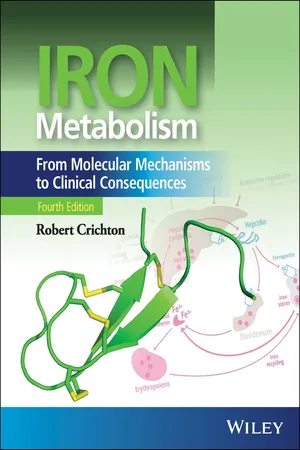
- English
- ePUB (mobile friendly)
- Available on iOS & Android
About this book
Iron is indispensable for the growth, development and well-being of almost all living organisms. Biological systems from bacteria, fungi and plants to humans have evolved systems for the uptake, utilisation, storage and homeostasis of iron. Its importance for microbial growth makes its uptake systems a natural target for pathogenic microorganisms and parasites. Uniquely, humans suffer from both iron deficiency and iron overload, while the capacity of iron to generate highly reactive free radicals, causing oxidative stress, is associated with a wide range of human pathologies, including many neurodegenerative diseases. Whereas some essential metal ions like copper and zinc are closely linked with iron metabolism, toxic metals like aluminium and cadmium can interfere with iron metabolism. Finally, iron metabolism and homeostasis are key targets for the development of new drugs for human health.
The 4th edition of Iron Metabolism is written in a lively style by one of the leaders in the field, presented in colour and covers the latest discoveries in this exciting area. It will be essential reading for researchers and students in biochemistry, molecular biology, microbiology, cell biology, nutrition and medical sciences. Other interested groups include biological inorganic chemists with an interest in iron metabolism, health professionals with an interest in diseases of iron metabolism, or of diseases in which iron uptake systems are involved (eg. microbial and fungal infections, cancer, neurodegenerative disorders), and researchers in the pharmaceutical industry interested in developing novel drugs targeting iron metabolism/homeostasis.
Frequently asked questions
- Essential is ideal for learners and professionals who enjoy exploring a wide range of subjects. Access the Essential Library with 800,000+ trusted titles and best-sellers across business, personal growth, and the humanities. Includes unlimited reading time and Standard Read Aloud voice.
- Complete: Perfect for advanced learners and researchers needing full, unrestricted access. Unlock 1.4M+ books across hundreds of subjects, including academic and specialized titles. The Complete Plan also includes advanced features like Premium Read Aloud and Research Assistant.
Please note we cannot support devices running on iOS 13 and Android 7 or earlier. Learn more about using the app.
Information
1
Solution Chemistry of Iron
1.1 Iron Chemistry
1.2 Interactions of Iron with Dioxygen and Chemistry of Oxygen Free Radicals
Table of contents
- Cover
- Title Page
- Table of Contents
- Preface
- 1 Solution Chemistry of Iron
- 2 The Essential Role of Iron in Biology
- 3 Microbial Iron Uptake
- 4 Iron Acquisition by Pathogens
- 5 Iron Uptake by Plants and Fungi
- 6 Cellular Iron Uptake and Export in Mammals
- 7 Mammalian Iron Metabolism and Dietary Iron Absorption
- 8 Intracellular Iron Utilisation
- 9 Iron Storage Proteins
- 10 Cellular and Systemic Iron Homeostasis
- 11 Iron Deficiency, Iron Overload and Therapy
- 12 Iron and Immunity
- 13 Iron and Oxidative Stress
- 14 Interactions between Iron and other Metals
- 15 Iron Homeostasis and Neurodegeneration
- Concluding Remarks
- Index
- End User License Agreement